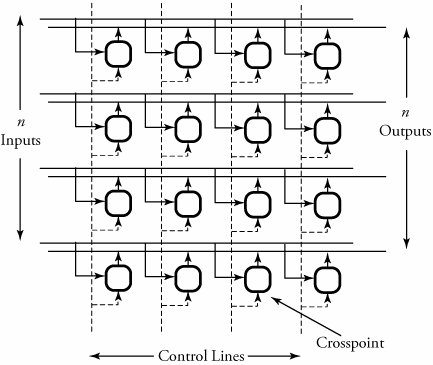Section 13.2. Crossbar Switch Fabrics
13.2. Crossbar Switch FabricsCrossbar switches are the building blocks of switching fabrics. A crossbar switch with n inputs and n outputs is shown by X n , n . Figure 13.1 shows a X 4,4 , or a 4 x 4 crossbar switching fabric. In a crossbar, every input can be uniquely connected to every output through a crosspoint . A crosspoint is the smallest unit of the switching function and can be built using a variety of electronic or digital elements, such as photodiodes, transistors , and AND gates. Figure 13.1. A crossbar switching fabric with n = 4 inputs/outputs Crossbar switches are considered strictly (wide-sense) nonblocking, as a dedicated crosspoint exists for every connection. This is clearly an attractive feature of a crossbar. The blocking, however, may occur when multiple packets are sent to the same output simultaneously . If a particular output port of the crossbar is idle, the desired connection can always be established by selecting the particular crosspoint dedicated to the particular input/output pair. Crossbar switches are conceptually simple. Their only potential problem is output port contention . The complexity of a switch lies in the complexity of its crosspoints. For an n x n crossbar, the complexity rises in a quadratic fashion and is equal to n 2 crosspoints. By some clever design work, the complexity can be reduced at the price of bringing certain blocking into the switching. |
EAN: 2147483647
Pages: 211
